
Alexander Heinle
Alex is a marketer at Zavvy. On this blog, he mainly shares insights gained from discussions with selected experts and from helping our customers set up and improve their onboarding or learning programs.

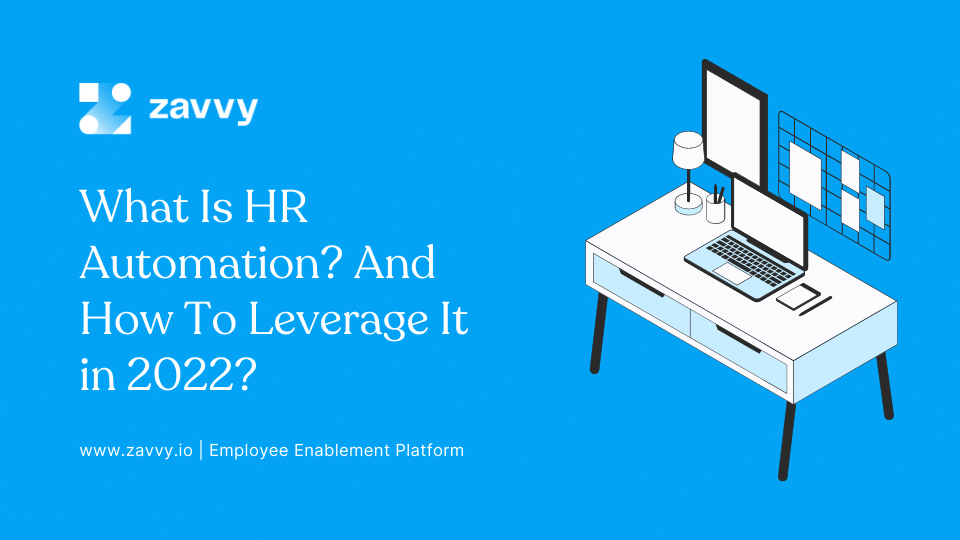
The beauty of HR automation is that it lets you automate critical but heavily manual tasks: the monotonous, repetitive, and prone to errors kind of work.
Valuable documents can go missing, forms may be left incomplete, and deliverables are left unfinished. But these can be old stories if you switch to an automated HR process.
Automating your HR processes leads to:
There is no need to take our word for it—we have numbers to back it up. Studies indicate automation can decrease administrative costs by 30% for HR professionals and 49% for employers.
But how can your team apply HR automation to experience these benefits?
Together with our curators, we have created a library of actionable digital marketing resources. Personalized to your team's needs.
HR automation replaces repetitive, administrative HR tasks with automated solutions to improve your HR department’s efficiency with little to no human input.
These are standard, time-sensitive, and prone to errors jobs yet critical. Some examples are payroll management, benefits enrollment, onboarding, attendance management.
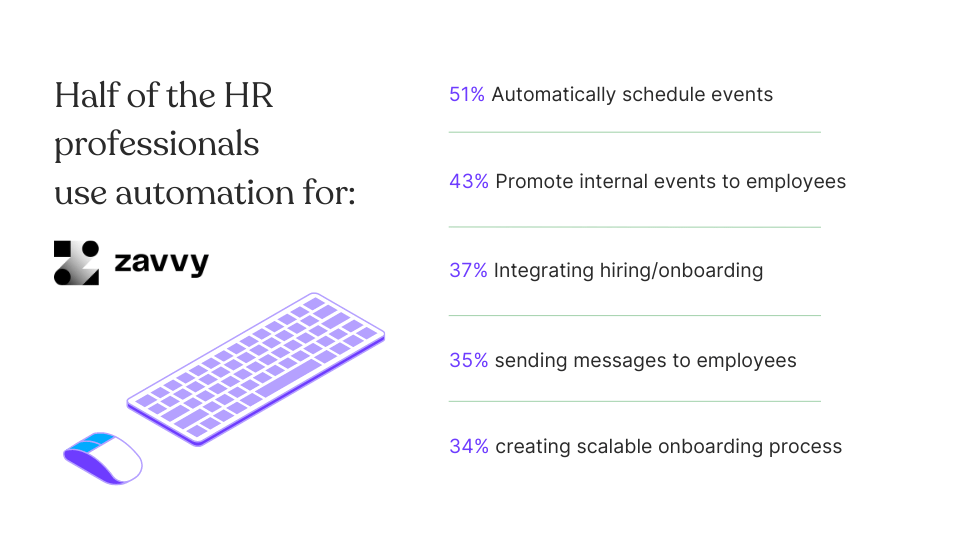
HR automation benefits your organization for a simple reason: to free up your HR personnel’s time so that they can concentrate on more complex issues like strategizing and decision-making, delivering better candidate, and employee experiences.
According to Zapier data, HR professionals save eight hours every week using automation. They can use these extra hours each week to focus on your biggest asset: your people.
HR teams have to spend less time completing redundant or repetitive tasks (think: creating calendar events, integrating systems, messaging employees).
The time saved from these tasks can be redirected towards more value-producing activities. For example, the HR professional can solve employees’ doubts faster, resulting in faster delivery.
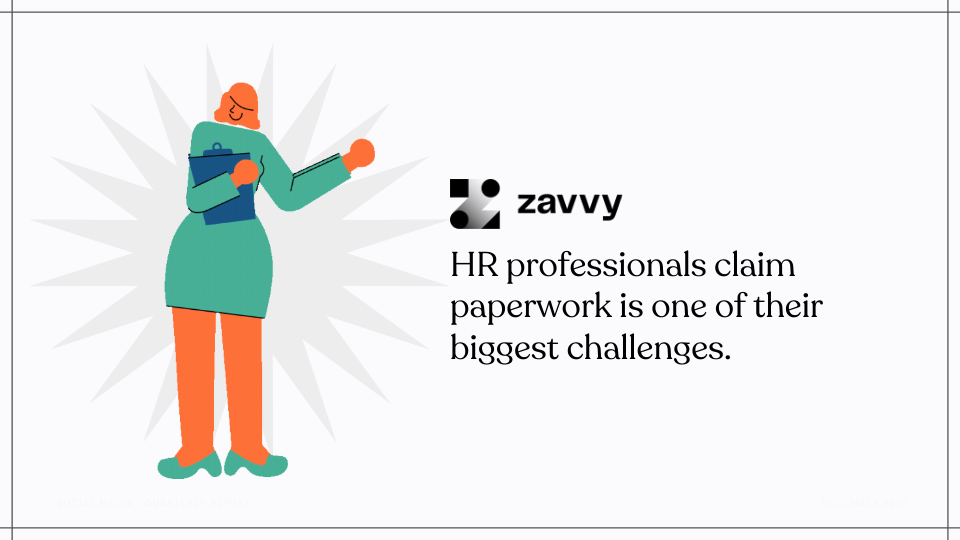
The majority of HR tasks are document-driven. They can be highly inefficient and time-consuming when done manually because of errors, filing issues, or “stuck “paperwork.
On the other hand, when you automate these tasks, you’ll see an instant boost in productivity and efficiency. No more looking for physical files or manually finding specific numbers. Once the data is entered into the automation program, managing documents will be a breeze.
Instead, the HR department can concentrate on culture building and communicating with the people, which, in turn, will facilitate organization-wide development.
Workflows often require input or action from other team members and departments. Delays in communications or handoff problems can result in unnecessary time wastage or workplace frustration.
Luckily, HR automation makes it easier for employees to route items to the right person for feedback, approval, or status updates, regardless of the department. Each team member also has improved visibility which is more than seeing the status of the requests and work items.
HR automation reduces dependency on manual labor that paves the way for human error.
There will be fewer opportunities for workplace mistakes, plus data across all departments, platforms, and apps are unified to provide more consistent records, eliminating repeated data entry.
Replacing your paper-based processing with HR process automation can save you some money.
Since you don’t have to print as many documents as before—or file them as a record—you minimize your need for stationery and storage space. All your documents can be recorded and accessed at the click of a button (thankfully!).
Your organization needs to adhere to data capture and management best practices to comply with applicable regulations. The problem here is that data security and compliance regulations are becoming more stringent and often complicated.
Even the most minor mistakes can result in huge penalties and tarnish your organization’s reputation, leading to loss of business opportunities.
HR automation best practices ensure all sensitive candidate and employee data are safely stored, plus go a step further to ensure all candidates are offered equal opportunities and treated fairly at the workplace.
Absolutely not. The whole point of HR operations automation is to help HR professionals work smarter and achieve better outcomes.
How? Automation creates more opportunities for you to connect and build meaningful relationships with others. The auto-pilot mechanism frees up HR task time, allowing you to focus on having actual conversations with your people instead of being bogged down with redundant admin tasks. When you automate manual HR processes, simple tasks and queries are handled automatically with little to no human involvement.
In other words, HR automation fosters and facilitates the “human “component.
For example, take your onboarding process. If your organization hires new talents often, HR managers won’t have to repeat the same process and procedures to educate the new hires about the company culture. Set up an automatic onboarding journey once, and reuse it again for the next onboarding program.
As a result, HR managers will have more time to welcome the new hires and get to know them personally. In this way, you can reduce employee turnover and improve employee engagement in the long run. It’s the ultimate win-win solution.
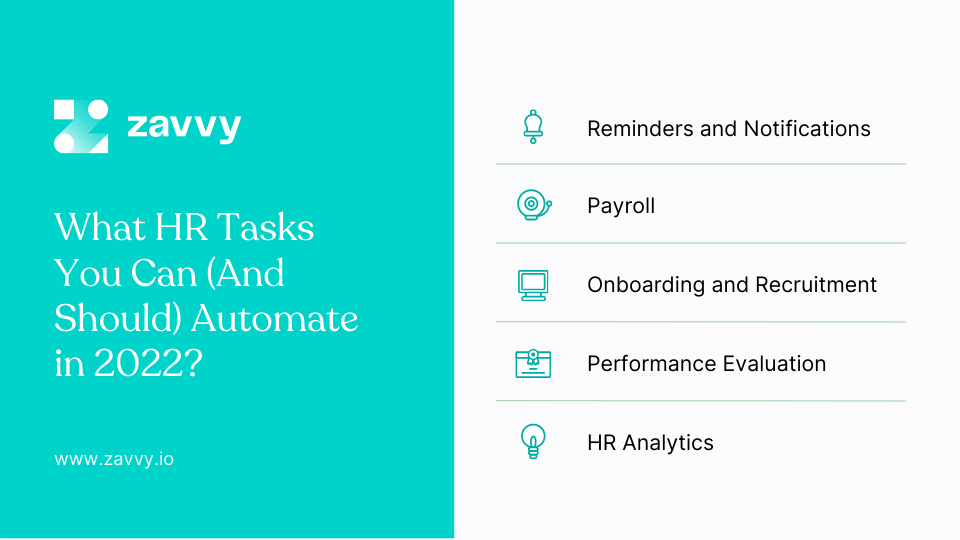
Now that we’ve established the benefit of HR automation, let’s discuss the HR processes you should automate.
Your HR department is already juggling several duties and responsibilities. Compared to that, manually sending reminders and notifications to ensure that every task is complete can be time-consuming and … frustrating.
HR software can send automatic email alerts to the HR team and respective employees, reminding them about upcoming deadlines, performance reviews, new starters, and other events. This will make it less likely for the overall team to forget important dates and tasks while also saving HR managers from chasing people to complete action items.
Automation, in this case, helps communication, saves time, and aids compliance by ensuring vital actions are taken at the appropriate time.
Doing payroll manually is a slow process that often takes hours (even days) and has a higher chance of producing errors. Using payroll systems like QuickBooks or ADP, on the other hand, will automate your payroll, resulting in:
Recruiting and onboarding new employees are two of the most critical jobs of HR managers. They involve a large amount of important paperwork and responsibilities.
When onboarding and recruitment are manual and paper-based, you deal with many documents. Lost paperwork is one of many problems that could happen as the records are often passed between different people and cause prolonged hiring processes.
HR automation can improve the sustainability experience by having the records on a computer system, allowing visibility between departments, minimizing human error, and preventing paperwork loss.
It also drastically reduces hiring time by accelerating candidate screening and background checks if coupled with data analytics. This is a huge advantage, considering 57% of job seekers lose interest in a job if the hiring process is lengthy.
We’ve passed the days where performance management was an annual event that determined whether employees were good at their jobs. Today, it’s a dynamic process that regularly evaluates employee performance by aligning it with your organization’s long-term and short-term objectives.
Although the frequency is increasing, the effort you need to evaluate employee performance decreases if you use an HR automation system. You can use the automation tools to identify, measure, and provide suggestions to improve employee performance without your active involvement. Automation also ensures each employee’s data is accurate, leading to fair appraisal for each employee.
Other advantages of automating employee performance include real-time feedback for effective employee development, training and development gap discovery, and actionable insights into counterproductive activities.
Human resources also deal with a lot of data. Unfortunately, most of this data goes unused due to the large volume that’s nearly impossible to sort through manually.
This is where HR analytics comes into the picture.
HR analytics refers to recording and analyzing HR data to enhance workforce performance and the impact of vital HR metrics on your organization’s overall performance. Here’s how it works:
Tracking employees' attendance and working hours is a must for every organization. However, manual recording time and marking attendance are ineffective ways to manage attendance.
Modern attendance tracking tools allow HR to monitor, track, and record employees working hours and attendance details automatically. This system can make the entire process easy and hassle-free. After using this system, the data will be compiled together and ready for payroll.
HR automation helps to eliminate physical paperwork and make HR activity more effective and error-free. So having the right HR automation tool can help automate these tasks and make a big difference.
As discussed, the whole point of HR process automation is to make the lives of HR managers and professionals easier and secure better outcomes—not to replace them. After all, a human touch is HR’s specialty.
But where should you draw the line?
You can never really replace the human element when it comes to the development and leadership of your workforce. HR has a pivotal role in answering complex benefits questions, having meaningful conversations, giving feedback, and addressing employee complaints and doubts.
Effective one-on-one interactions with employees are what sets a workplace apart. Technology is just another tool in the HR’s toolbox—one that they should leverage to free up their time and focus on tasks that require or are enhanced by human conversations.
Here, we’ll discuss real-life examples and case studies to help you understand how companies embrace HR process automation and achieve significant milestones.
It was supposed to be just another payroll run for FuelCell Energy when the company’s payroll manager realized that each employee was going to receive someone else’s pay.
FuelCell Energy’s HR director Sandi Mauro, along with her small team, had compiled Excel spreadsheets with updated workers’ compensation numbers for the 600-strong workforce. Unfortunately, one of the spreadsheets was sorted incorrectly, leading to veterans getting paid as new hires, rank-and-file workers as the senior management—it was utter chaos.
While Mauro managed to avert the crisis by stopping payroll run a day before it was processed, the incident solidified the need for better controls over compensation planning processes.
There were problems before, too. Manual payroll often leads to errors and there was no transparency into how pay was being calculated for employees.
This was when FuelCell Energy decided to invest in SR automation software. 90 days later, the results were clear, the software:
The Osceola County’s Sheriff’s Office faced a nationwide shortage of police officers. As a result, the department knew they needed an effective alternative for their paper-based recruitment process that often led to lost forms, several stacks of paperwork, and stunted communication between departments and applications.
That’s when the staff implemented HR automation in a pre-employment online assessment.
Within the first year of implementation, the Osceola County’s Sheriff’s Office scaled its recruiting efforts from 446 applications in 2012 to 1,305 applications in 2013. More importantly, the department found better quality candidates and filled the vacancies faster.
Overall, automating recruitment enabled the Sheriff’s Office to complete paperless background checks and send automated emails to candidates to update them about their application status. The $2,000 saving of office supply is another cherry-on-top for them.
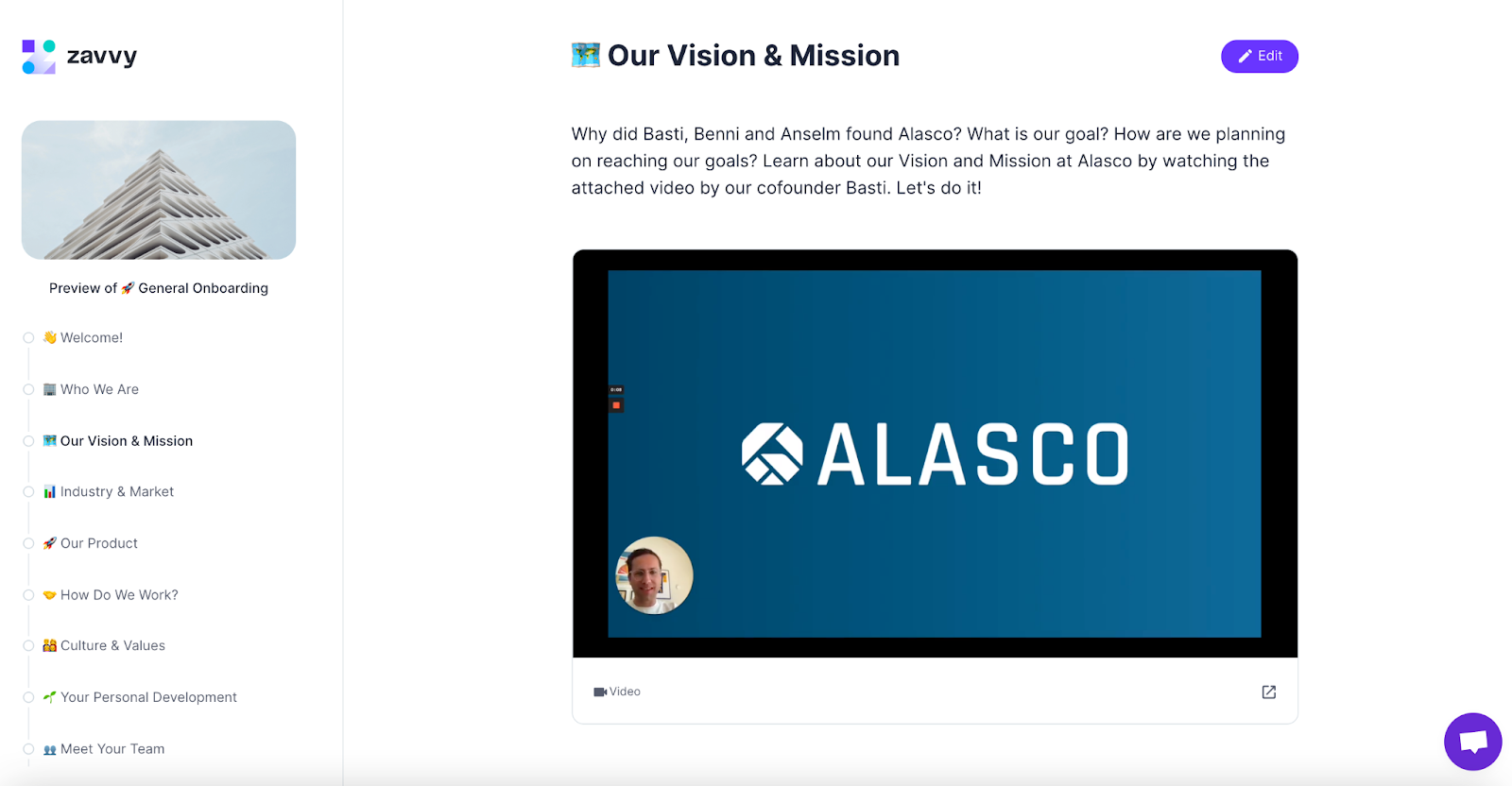
Alasco had ambitious plans in line with its mission to help real estate owners maximize ROI: the company planned to grow its workforce by nearly 60% while adapting to a hybrid work model.
Initially, onboarding was not a big issue. New hires would be personally introduced to essential topics by superiors and were given detailed email instructions to make the first few weeks comfortable.
Things changed when Alasco had to go remote. It became more challenging for the fast-growing company to virtually give new hires the same high-quality onboarding experience. This was something they wanted to continue doing.
Alasco uses Zavvy’s onboarding software to automate (and accelerate) onboarding, helping the company cut down manual workload in half and create structured internal processes to deliver a rich and diversified experience beyond the traditional emails.
New employees love this new and improved experience, too. They rated their hiring experience with Zavvy an impressive 4.7 out of 5 stars.
In this section, we’ve compiled a shortlist of HR automation tools to help you get started with automating everyday HR admin tasks.
Want to take employee experience to another level? Use Zavvy to map consistent employee journeys and lay the foundation for long-lasting relationships right from the start.
Zavvy takes care of everything: onboarding, employee training and development, and connection programs to cultivate a harmonious and engaging work culture. What’s more, you can also use Slack’s workflow builder with Zavvy to create your own workflow automation and enhance onboarding efficiency.
No time for creating the journey from scratch? No worries. Zavvy offers pre-made templates that you can further customize based on your needs. In addition, our support team will help in every step until you’re confident to manage things on your own.
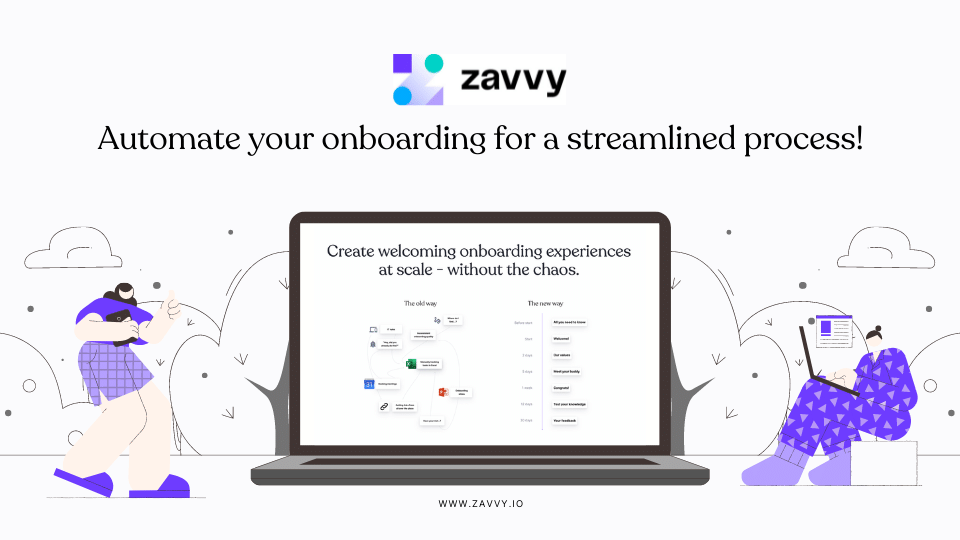
At this point, we’re going to assume you’re all in to automate employee onboarding.
But the next thing to figure out is how to do it correctly—how do you develop a consistent, time-efficient, and better way to welcome and retain your company’s new employees.
To help you out, we provide some typical applications of how our clients use Zavvy’s onboarding tools:
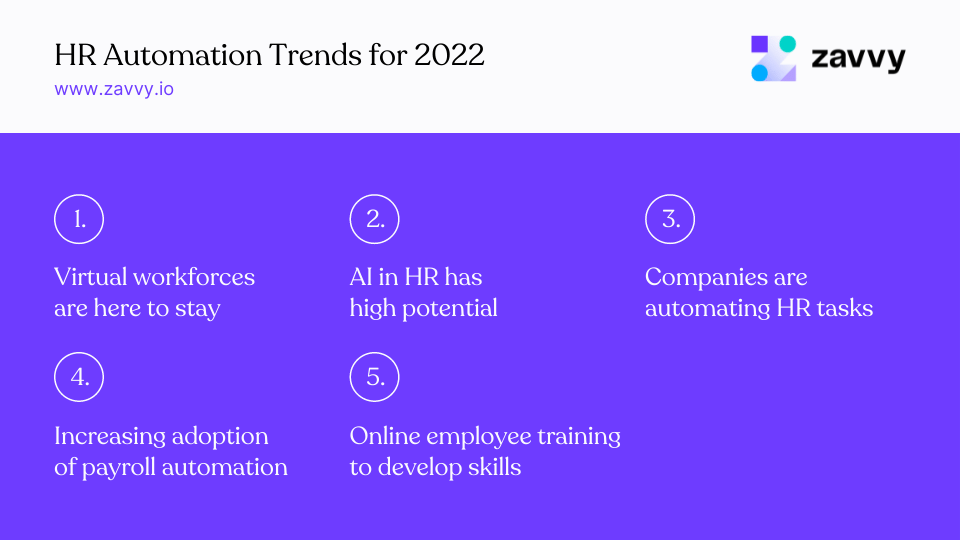
Let’s take a brief look at the latest HR automation trends to help you create an up-to-date automation strategy for your organization.
Many major companies like Twitter, Shopify, Facebook, and Slack have embraced and elevated working from home. This move makes sense considering 65% of workers prefer to continue working from home post-COVID.
Keeping this in mind, HR departments need to adjust to this reality and create workflows and strategies that support a fully remote or hybrid work culture.
Recruitment can be a repetitive and time-consuming process—making it the perfect area to automate. Still, companies are currently automating only 6% of all recruitment tasks.
We can expect more recruitment-related tasks to become automated over the next few years, especially with the recent advances in AI and HR tools.
Human resources in the digital age are becoming increasingly demanding and complex. To keep up, companies will apply AI automation in many areas, including onboarding, training, and recruitment.
This will enable HR to anticipate inquiries and issues, deliver a more personalized approach, minimize repetitive tasks, focus more on tasks requiring a human touch, and ensure 24/7 availability through AI-powered chatbots.
The main idea behind employee training is to elevate productivity among staff. With workforces going remote, it’s only time before employee training will follow suit and become online.
Expect companies to turn to automated online learning platforms and workshops to provide employees with learning opportunities to develop and enhance their skill sets.
Over the last few years, many companies have implemented payroll software to automate various processes, from sending out invoices to sending payments directly into the employee’s bank accounts.
The time saved can be better spent holding meaningful one-on-one conversations and leading employees towards success. Avoiding human error when processing payments, which is costly in terms of money and time, is another significant benefit.
There’s increasing pressure on companies to deliver exceptional employee experiences in the wake of the Great Resignation and the pandemic. Through HR automation, you can create unified workflows to improve candidate/employee journeys and prioritize your company’s biggest asset: its people.
Take your first step towards automating HR tasks with Zavvy. Sign up for a free demo and experience how our customized solutions can support and uplift your employees and candidates.
Upskill your team every week with the best contents and personalized recommendations.

The beauty of HR automation is that it lets you automate critical but heavily manual tasks: the monotonous, repetitive, and prone to errors kind of work.
Valuable documents can go missing, forms may be left incomplete, and deliverables are left unfinished. But these can be old stories if you switch to an automated HR process.
Automating your HR processes leads to:
There is no need to take our word for it—we have numbers to back it up. Studies indicate automation can decrease administrative costs by 30% for HR professionals and 49% for employers.
But how can your team apply HR automation to experience these benefits?
Get a demo!
We'll be happy to show you around and answer all your questions.
Trusted by innovative companies



We'll be happy to show you around, answer your questions, or arrange a free trial.
Erhalten Sie eine kostenlose Demo unserer Onboarding-Software.
Vertraut von



Your Training & Development Strategy - Solved in 1 Tool.
Trusted by innovative companies



We'll be happy to show you around, answer your questions, or arrange a free trial.
Learn how Zavvy helps you drive performance, development, and engagement.
Trusted by innovative companies



We'll be happy to show you around, answer your questions, or arrange a free trial.
We'll be happy to show you around and answer all your questions.
Trusted by innovative companies



We'll be happy to show you around, answer your questions, or arrange a free trial.
Gerne zeigen wir Ihnen ganz unverbindlich unsere Plattform im Detail.
Vertraut von modernen Unternehmen



Get a demo!
We'll be happy to show you around and answer all your questions.
Trusted by innovative companies



We'll be happy to show you around, answer your questions, or arrange a free trial.
Erhalten Sie eine kostenlose Demo unserer Software für Mitarbeiterenwicklung und Training.
Moderne Unternehmen
setzen auf Zavvy


